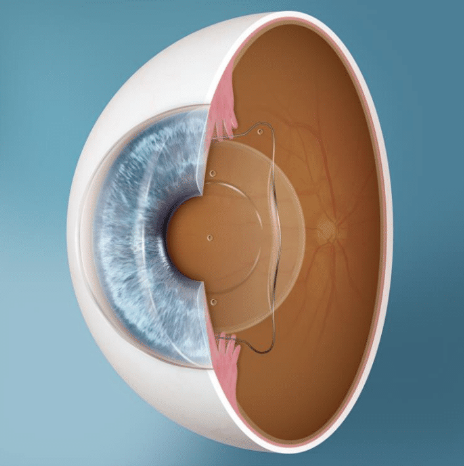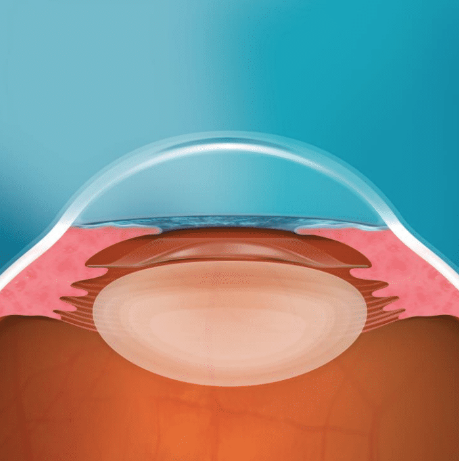With EVO ICL you can have sharp, clear vision without the burden of glasses or contact lenses.
With EVO ICL you can have sharp, clear vision without the burden of glasses or contact lenses.
Utah Valley Eye Center is one of Utah’s leading providers for the EVO ICL (Implantable Collamer Lens)


What is EVO ICL?
EVO ICL surgery is a method of vision correction for nearsighted patients or patients with astigmatism. This procedure involves a small biocompatible lens that is inserted into the eye in front of the natural lens and behind the iris (the colored part of the eye). EVO ICL is meant to reduce or eliminate the need for glasses or contacts without the need to remove corneal tissue. EVO ICL implants are reversible by simply removing the lens if necessary.

What is EVO ICL?
EVO ICL surgery is a method of vision correction for nearsighted patients or patients with astigmatism. This procedure involves a small biocompatible lens that is inserted into the eye in front of the natural lens and behind the iris (the colored part of the eye). EVO ICL is meant to reduce or eliminate the need for glasses or contacts without the need to remove corneal tissue. EVO ICL implants are reversible by simply removing the lens if necessary.

What to expect during the EVO ICL procedure
EVO ICL surgery is a quick and painless outpatient procedure. When arriving at the surgical center your nurse will give you drops to both dilate and numb your eyes. Dr. Gardiner will then gently insert the lens through a small incision in your cornea. This lens works with the natural lens of your eye to refract light directly onto your retina for clear vision. The procedure is typically painless and takes 10-15 minutes per eye. You can experience improved vision right away and a quick recovery time.
What to expect during the EVO ICL procedure
EVO ICL surgery is a quick and painless outpatient procedure. When arriving at the surgical center your nurse will give you drops to both dilate and numb your eyes. Dr. Gardiner will then gently insert the lens through a small incision in your cornea. This lens works with the natural lens of your eye to refract light directly onto your retina for clear vision. The procedure is typically painless and takes 10-15 minutes per eye. You can experience improved vision right away and a quick recovery time.
Benefits of EVO ICL






Benefits of EVO ICL






Did you know that EVO ICL saves you thousands in the long run? Say goodbye to the never-ending expenses of glasses and contacts, and say hello to a world of clarity and financial freedom today!
See what patients have to say about
EVO ICL at UTAH VALLEY EYE CENTER!
Payment options for EVO ICL
Payment in Full:
This payment can be made using cash, check, or credit card
Flex Spending Plans:
This payment can be made using cash, check, or credit card
Financing Plans:
Utah Valley Eye Center offers a 12-month no-interest financing plan with a 50% down payment before ordering your lenses.
EVO ICL FAQ
ICL surgery is well-suited for a wide variety of people. Ideal candidates are aged 21-45 with nearsightedness and have maintained a stable prescription for at least one year.
ICL is not an option for patients who are pregnant, nursing, or those with a history of eye disease. Please discuss your history with Dr. Gardiner at your complimentary consultation.
Yes, ICL has been approved in Europe since 1997 and in the U.S. since 2005. In that time, over 2,000,000 eyes have been implanted by certified, specialized surgeons.
ICL is made out of a biocompatible material called Collamer. This material consists of collagen which naturally occurs in your body.
No, the lens is placed behind the colored part of the eye (iris), where it is invisible to both you and others. Only your eye doctor will be able to see that you have had ICL surgery.
No, the ICL is not typically noticeable after it is implanted. It does not attach to any structures within the eye and does not move around once it is in place.
Like with any surgery, ICL does have potential risks. Rarely, an elevation of eye pressure can occur after the procedure. Other risks include an increase in astigmatism, loss of corrected vision, or clouding of the crystalline lens. It is important to know that these risks are rare and treatable by Dr. Gardiner if they occur.
The ICL lens will remain in the eye until you reach the age of 65+ when you will likely start to develop cataracts. Cataracts are a clouding of the natural lens. At the time of cataract surgery, the ICL will be removed and cataract surgery performed as usual.
EVO ICL FAQ
ICL surgery is well-suited for a wide variety of people. Ideal candidates are aged 21-45 with nearsightedness and have maintained a stable prescription for at least one year.
ICL is not an option for patients who are pregnant, nursing, or those with a history of eye disease. Please discuss your history with Dr. Gardiner at your complimentary consultation.
Yes, ICL has been approved in Europe since 1997 and in the U.S. since 2005. In that time, over 2,000,000 eyes have been implanted by certified, specialized surgeons.
ICL is made out of a biocompatible material called Collamer. This material consists of collagen which naturally occurs in your body.
No, the lens is placed behind the colored part of the eye (iris), where it is invisible to both you and others. Only your eye doctor will be able to see that you have had ICL surgery.
No, the ICL is not typically noticeable after it is implanted. It does not attach to any structures within the eye and does not move around once it is in place.
Like with any surgery, ICL does have potential risks. Rarely, an elevation of eye pressure can occur after the procedure. Other risks include an increase in astigmatism, loss of corrected vision, or clouding of the crystalline lens. It is important to know that these risks are rare and treatable by Dr. Gardiner if they occur.
The ICL lens will remain in the eye until you reach the age of 65+ when you will likely start to develop cataracts. Cataracts are a clouding of the natural lens. At the time of cataract surgery, the ICL will be removed and cataract surgery performed as usual.
 Order Contacts
Order Contacts Make Payment
Make Payment Patient Portal
Patient Portal

